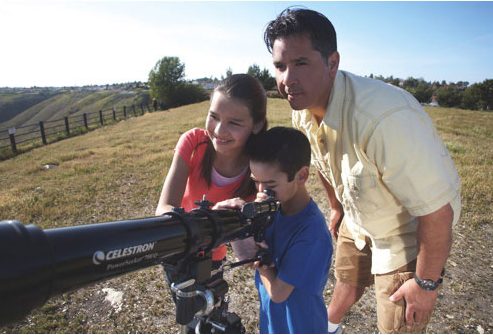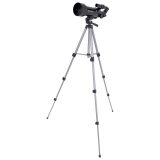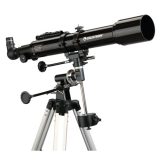 Whenever I think of telescopes, I think about my grandfather. He had this old beginner telescope, and on clear nights he would unpack it from its worn red box, and set it up on the back porch so the grandkids could peer into the night sky. He’s the one who showed me the Big Dipper, and tried to show me the constellations. I was young, so I couldn’t exactly see all the bulls, archers and characters he tried to show me in the stars. But, I loved spending time with my grandfather and learning about the moon, space and the stars. I actually got that telescope when he died, but my idiot cousin tried to use it as a baseball bat and of course it never worked again. I’ve not had a telescope since then, but it is something I’ve thought about purchasing for a long time now. If you’ve been thinking about making the same type of purchase, let me give you five tips for buying your first telescope.
Whenever I think of telescopes, I think about my grandfather. He had this old beginner telescope, and on clear nights he would unpack it from its worn red box, and set it up on the back porch so the grandkids could peer into the night sky. He’s the one who showed me the Big Dipper, and tried to show me the constellations. I was young, so I couldn’t exactly see all the bulls, archers and characters he tried to show me in the stars. But, I loved spending time with my grandfather and learning about the moon, space and the stars. I actually got that telescope when he died, but my idiot cousin tried to use it as a baseball bat and of course it never worked again. I’ve not had a telescope since then, but it is something I’ve thought about purchasing for a long time now. If you’ve been thinking about making the same type of purchase, let me give you five tips for buying your first telescope.
1 – What Do You Want to Use it For?
You’ll find many models and types of telescope out there, so the first thing you’ll need to figure out is what you’re going to use it for. Are you going to use it for peering up at the twinkling stars, or for bird-watching? And, by bird-watching I mean the feathered creatures of the wild, and not the British slang for looking at girls. This is a family blog, after all. But, how you’re going to use it will influence what you buy. The same goes for whether you want something you can mount on your deck, or carry around with you? How much room do you have to store it? These are questions you have to ask yourself before even setting foot in a store. However, for both terrestrial and astronomy pursuits, you’ll want to make sure you pay close attention to the aperture, because the higher the aperture the sharper and brighter the view will be, as well. Aperture refers to the diameter of the telescope’s main optical component (consisting of either a lens or mirror). The size of your telescope’s aperture determines how much light it can capture. The more light that is captured the more objects you can see in the night sky. Simple right? Of course, a higher aperture also means a higher cost, but as with anything, you pay for what you get. If you’re thinking of just looking at land-based objects, you may also consider investing in a good pair of binoculars.

2 – Is the telescope Easy-To-Setup?
If you’re new to star-gazing or wildlife-viewing, then you’ll probably want something that is relatively easy to set up. If it takes a long time or a whole bunch of effort to set up your scope every time, chances are you’ll only use it a few times (like during the annual Perseids meteor shower). However, if you’ve got a good beginner scope that’s easier to setup, then you may be pulling it out to observe more often. A good choice is the Celestron Travel Scope 70 x 400mm Portable Refractor Telescope. It has an infinitely compact and portable design, plus great optical performance, so it’s ideal for beginners. The Celestron Discovery PowerSeeker 70 x 700mm Refractor Telescope is also a perfect entry-level scope, featuring easy setup, and lots of magnifying power.
3 – Do You Want Refractor or Reflector as your first telescope?

Telescopes come in two types of optical design: reflector and refractor. Refractors need the least maintenance, which is good for beginners. Lots of smaller refractors are also light enough to mount on a sturdy camera tripod, so they are pretty handy “grab-and-go” scopes. Reflectors, on the other hand, offer the best value for money when it comes to astronomy, as they have a better “size for your dollar” ratio.
4 – A Good Mount
One of the most overlooked aspects of a telescope is the mount, and it as important as any other part of your scope. The mount is crucial for stabilizing your telescope, and determining how easy it is to follow a particular star or body while viewing it. So, if you have a lower quality mount, you risk having your telescope sway in the wind, and then you have to re-find, re-focus and start all over again. So, make sure your first telescope has a decent mount, and avoid the frustration.
5 – Buy For Your Budget
Likely one of the biggest factors in your telescope-buying decision will be your budget. My advice would be to stick to the scope that doesn’t just meet your budget, but also meets your hobby needs. It may be worth it to spend just a little more to ensure you have something that will last for longer, or that you can grow into. And remember, as a general rule, the higher the aperture, the better the quality, but the higher the price. So, always try to budget for the highest aperture possible.
Are you interested in buying a telescope? Do you think I missed anything that you’d like to know about buying a first telescope? Let me know in the comment section below. And don’t forget to check out Nicki Seaborn’s article on Five Tips for Setting Up Your First Telescope, after you make your decision and purchase. She shares lots of great info on getting your new scope up and pointed at the sky!



